According to your Rocksim plot, the sustainer would have been supersonic from somewhere around 12 seconds after liftoff to 14 seconds after liftoff. Could you zoom in on the first 20 seconds and re-post? In the rocksim plot preferences you can make the plot end at apogee or other events. I'm afraid that your Mach inhibit timer may have expired just in time for the altimeter to react to a Mach-induced false apogee.
Adrian, Here's a better chart (below). It different because I remembered getting rid of the coast between stages.
I set the mach delay on both the RRC2X and mini to 12 seconds. That's the maximum allowed time for the X (but the mini goes up to 30) so I set them to the same delay. 12 seconds is plenty for a single stage rockets but a two stage bird has twice the possible thrust time. If there is a 5-6 second delay between the stages firing the time at mach gets even longer. In the chart below you can look at the green lines which is the predicted velocity. If the sustainer is two seconds hesitating to fire its motor than the sustainer will still be mach after 12 seconds. A 20 second delay would have been better. If the MW altimeters produce a false apogee above mach then that's part (or all) of my problem. Does this make sense?
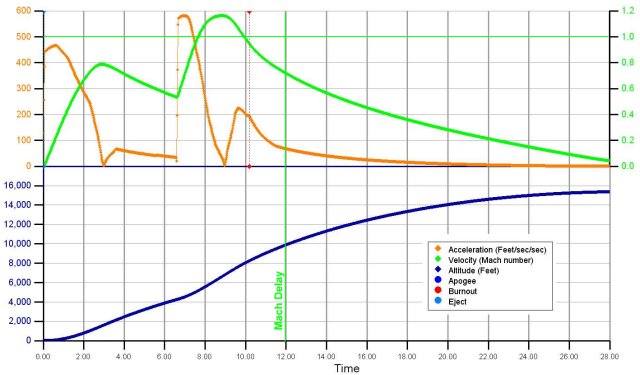
If you look at the ignition of the sustainer trail (in pic 2) vs the flight to that point, there is a definite change in angle of flight. I would say roughly 20*, is this the delay in ignition you are looking for? Or, am I just stating the obvious????? 😳

Good luck, guys!
If you look at the ignition of the sustainer trail (in pic 2) vs the flight to that point, there is a definite change in angle of flight. I would say roughly 20*, is this the delay in ignition you are looking for? Or, am I just stating the obvious?????
The fact that the booster contrail is not in that picture, only a wispy trail, leads me to believe that there was more delay than the programmed 1/2 second. That picture was rotated 60 degrees to the right to make the track look more vertical (and to make the picture fit the forum page better). This picture below is the three pictures in sequence that Bert took as it was heading west, superimposed on each other. Up to the separation, the ground track is straight, however the Dc20 only updates once every 5 seconds, and that is the total burn time of the motors. So... you could be right-on indicating a change in direction. Something had to cause that kink in the smoke trail. A bit later, right before the separation occured, there was a very violent spin happening and afterwards the motor trail smoothed out again. The momentum should have kept it going in the same general direction. Keep in mind the rocket was weathercocking a bit to the west.
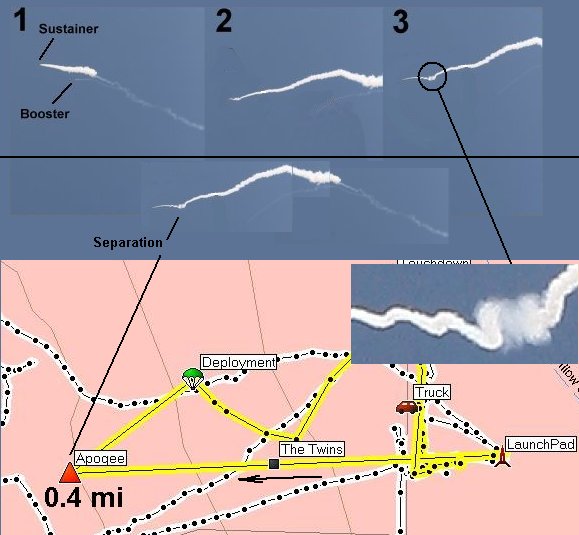
I made a vacuum chamber tonight, to test the rocket controllers, using a 2-1/2 gallon "Montana" Jar from Target $19.95. After modifying the top, which has a seal in it, I connected it to my little 1.5hp shop-vac and was able to suck the insides down to an altitude of about 3200 feet elevation, indicated by a common dashboard car altimeter. A 3.25hp vac brought it to 4000 ft, but it was akward to use.

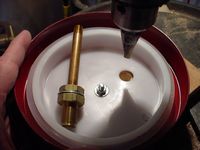
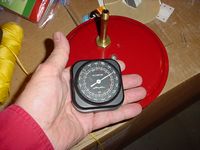

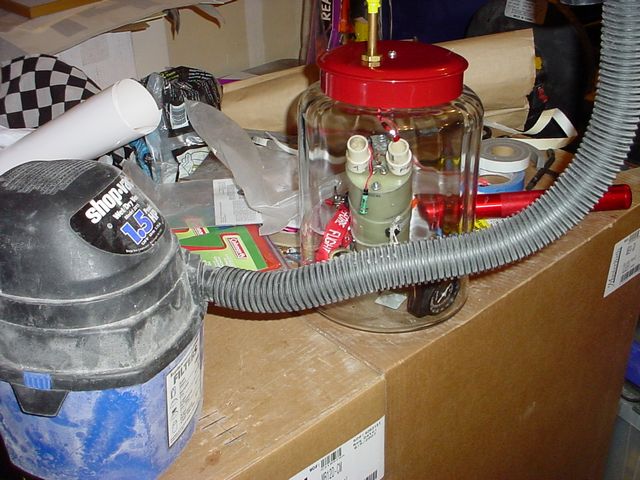
I then tested the RRC2X and RRc2 Mini, still mounted in the avbay, with 12V LEDs from Radio Shack, and they both read within 150 feet of each other, 3280 and 3165. When I let off the vacuum before 12 seconds, which is what I programmed mach delay to be, the apogee charge on the RRC2X went off only after the altimeter was less than 800 feet. I believe that is by design. However, the RRC2-mini's apogee went off as soon as apogee was detected, when I turned off the shop-vac. That wasn't right - I think.
I took the avbay apart and rechecked my settings on the RRC2-mini and I think its possible that there was no mach delay set. I was getting a long series of 10 beeps with a double chirp continuosly on that set point menu. I reset it to 12 seconds and put it back in the jar for another test.
Now when the vacumm is applied for less than 12 seconds, both of the apogee charges will not fire until the altimeter reads less than 1000 feet. The main charges fire immediatley after. If I wait more than 12 seconds, then the apogee charges fire as soon as I flip the switch off on the shop-vac. Now they are acting the same.
Root Cause: Pilot Error The transition through Mach created a reversal in pressure and because the mach delay was not set, the RRC2-mini decided it was at apogee and fired the drogue charge. This is what caused the separation during the boost of the sustainer at high speed which created excessive forces on the shock cord system, causing the shear of the cord and the loss of fin can. 😳
Good news: The rest of the design was OK. There is something to be said for the simplicity of the RRC2X over the mini. And...I can now functionally test my altimeters before all future flights. Yay! 😀 (anyone is welcome to come over and use my set up - beer is in the fridge). 😉
Adrian [and Jim A. if you happen to read this]. Do you concurr with my findings?
Give me DIP switches or jumper blocks any day!
Ken
I want Slipstick on My side. 😆
Adrian [and Jim A. if you happen to read this]. Do you concur with my findings?
Yep, I think you nailed it. Good sleuthing, Mike. Any luck finding the fin can yet?
Mike got sick on sat and I pulled a newbie stunt and didn't cross the fence about 1.2 mi to the west. 😳 So no luck on my trek.
Joe Hinton also gave it a good try on Friday. I'd like to thank Both Joe and Greg for taking the time and putting forth the effort in looking for the fin can. I think (according to Art) that its at least 2-3 miles away.
Since I don't have rocksim figured out yet, I have to ask this.
Can you sim the sustainer and see if it would have been stable? Is there a possibility that it went squirrelly after we lost sight of it?
I talked to Jeremiah and we both agreed that what we saw was the top half after the separation. So, all that tumbling talk I said earlier was false. The pictures you posted cleared up what we saw, they are worth their weight in Gold.....
Where did you post that landowner map? Someone told me about it, but can't seem to find it.
I believe that this is the map referenced.
This thread has some discussion about the map and a suggestion that we start tracking landings.
Can you sim the sustainer and see if it would have been stable? Is there a possibility that it went squirrelly after we lost sight of it?
Rock sim says it would have been unstable (-8 margin), but it may have entered into a flat spin see the below photo and the next post - very revealing sequence of events from Ray's Camera, that I zoomed in on and played around with the contrast.
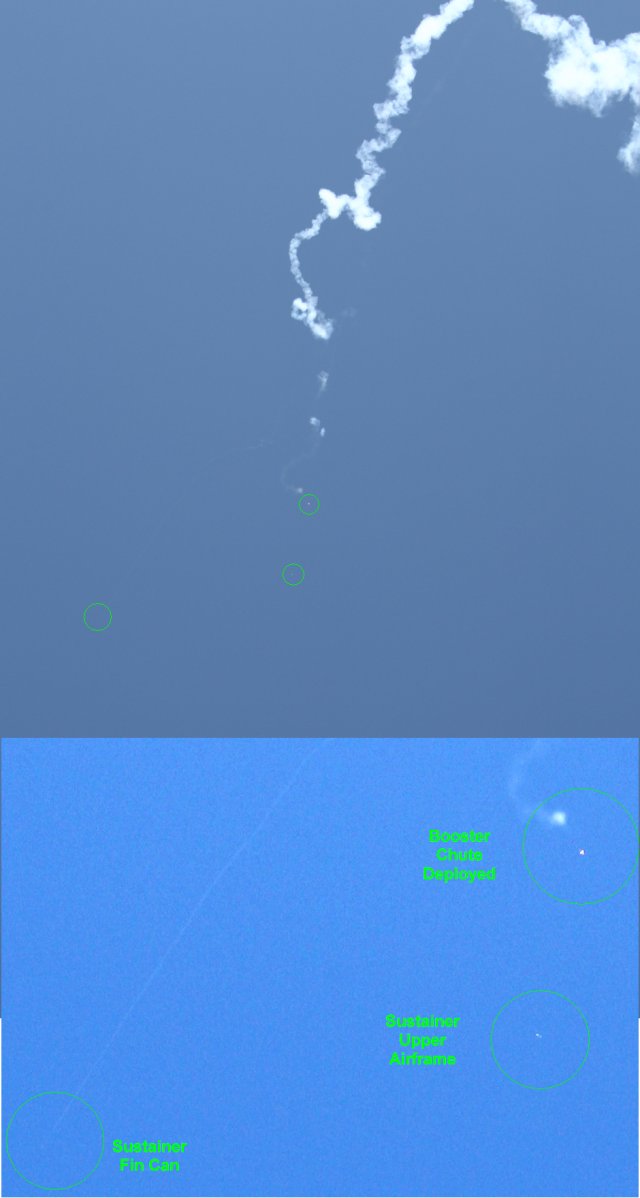
Here's a flight sequence, shows separation and Fin can coasting (possiby - I hope - a flat spin in free fall) afterwards - scroll away!!


